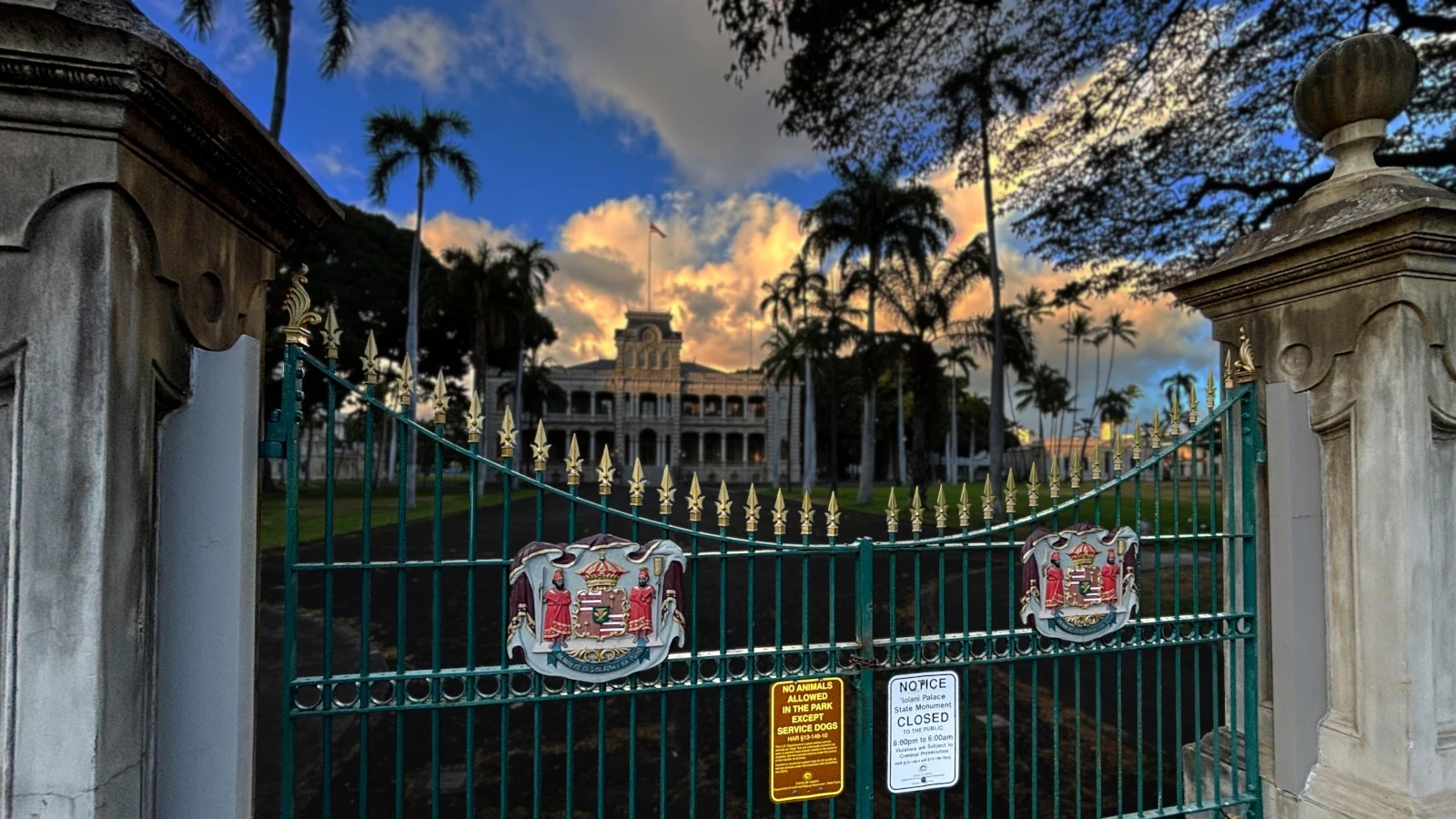ʻIolani Palace stands as the only royal palace in the U.S. and is a lasting symbol of Hawaiʻi’s proud heritage and sovereign past. Completed in 1882, the grand palace sits in the center of 11 acres in Downtown Honolulu, surrounded by a wall.
At that time, the wall was eight feet high, made of coral blocks, with large wooden gates on all four sides. The wall was meant to protect, impress and set the royal grounds apart, but after the Wilcox Rebellion of 1889 — an attempt by Hawaiian nationalist Robert Wilcox to restore royal authority — the wall was lowered to just over three feet and topped with a painted iron fence, a visible sign of shifting power in the Hawaiian Kingdom.
Decorated with gold painted finials and adorned with the Hawaiian Kingdom Coat of Arms, each gate had its own name and a specific purpose.
At the front of the palace on King Street, Kauikeaouli Gate is named for Kamehameha III. This gate was only used for ceremonial occasions, such as when royalty or esteemed foreign dignitaries were expected.
Hakaleleponi Gate is named for Queen Kalama, the wife of Kauikeaouli. This passageway is posted at the back of the palace and was used by palace staff and royal retainers.
Used by tradesmen who came to work or deliver goods to the palace, Kīna‘u Gate sits along Richards Street. The name of this gate honors the mother of Kings Kamehameha IV and Kamehameha V.
The little lane on the Diamond Head side of the Palace is called Likelike Street, which is also the name of the gate that sits on that side, near the Hawaiʻi State Library. Reserved for the royal family’s private use, the name honors Princess Likelike, sister to King Kalākaua and Queen Lili‘uokalani.
Added to the mauka side of the palace upon Queen Lili‘uokalani’s accession to the throne is a fifth gate. This smaller entryway is located behind what is now the Barracks and was built specifically for the Queen’s husband, John Dominis.
Some say these gates hold more than just royal names and historical memory. Over the years, a number of people have reported strange occurrences near the gates, especially after nightfall.
In 1925, Mrs. Kahanawale Ka‘awa, the wife of a former Royal Guardsman, visited the Palace for the first time in forty years. Her husband, P.K. Ka‘awa, was said to be one of the best-known guardsmen during the reign of King Kalākaua. Mrs. Ka‘awa described how the wives of the guards often slept near the gates to which their husbands were assigned. They slept on simple mats with a kihei for a covering, she said, and explained that their presence reassured the men during their nightly vigils, because the gates had a reputation for weird and mysterious happenings. Though all the gates were subject to strange events, Kauikeaouli Gate was the most feared by the guards.
The gate, though locked, would sometimes snap open on its own without warning. If a guard tried to close or relock it, he’d be thrown to the ground, knocked senseless by some unseen entity. Mrs. Ka‘awa claimed she saw the gate open suddenly with her own eyes, several times, as her husband stood watch. Many believed that the spirit was King Kamehameha III, and Ka‘awa never dared close the gate until he was sure the spirit of the King had passed through.
Another account describes a thunderous noise shattering the silence of the night. It sounded like a colossal foot striking the lock of the front gate. With a gust of wind, the gate would swing open, revealing the regal form of Kamehameha III following behind his guardian ancestor, the formidable figure of Iwikauikaua, who carried his own head under his arm.
The guards, upon witnessing these ethereal visitors, would immediately fall to their knees, prostrating themselves in reverence before the spectral chiefs as the ghostly pair made their way toward the palace.
The other gates also had mysterious disturbances. The Likelike Gate, in particular, is said to give some visitors an overwhelming sense of being watched. Glen Grant told a story on his ghost walk about being hit over the head after walking through the Likelike Gate. When he turned to see who had accosted him, he only saw the empty guard shack.
A few years later, when I was running my own ghost tours, an enthusiastic follower meant to surprise my guests one night. Without telling me of his intent, he dressed all in black, wore a dark cloak with a hood, and painted his face black, as well. He stood in the guard shack, waiting for my group to pass through the Likelike Gate so he could jump out and scare everyone.
Hours later, this man met me and explained what he intended to do, but said that when he began to step forward to jump out of the guard shack, a large pair of arms wrapped around him and pulled him back in. If anyone remembers those little shacks, they’ll recall that they were only large enough for a single person to stand upright unless one was very slim. The man woke up in the dark, sitting at the bottom of the shack, with no knowledge of who had grabbed him or what had happened afterward. Neither I nor anyone on my tour knew he was there.
Whether the entities in these stories are spirits standing guard, or simply echoes of a kingdom that refuses to be forgotten, one thing is clear — these gates still hold mana. And maybe, just maybe, they still open for those who once walked here in another time.





